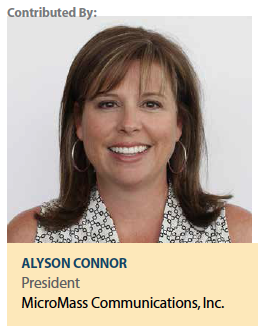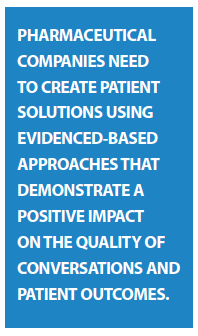 Pharma has expanded the scope of patient solutions in the marketplace, but most of these solutions remain product-focused. The emphasis is currently on product messaging or tools to make access to products more convenient and easier for the patient. Sure, these solutions can enhance the product experience, but do they really add any real value for the patient?
Pharma has expanded the scope of patient solutions in the marketplace, but most of these solutions remain product-focused. The emphasis is currently on product messaging or tools to make access to products more convenient and easier for the patient. Sure, these solutions can enhance the product experience, but do they really add any real value for the patient?
Go beyond the patient to provide value.
Currently, the pharmaceutical industry is focused on how to capture the attention of patients and provide value through tangible content. Moving forward, the pharmaceutical industry’s focus should be on influencing the process of care and supporting patients instead of interrupting them. In order to do this, pharmaceutical companies should stop thinking about patients and providers as separate entities.
It’s no longer enough to educate the provider or empower the patient. Education and empowerment are important, but only when they can lead to the desired effect — improving patient outcomes. The best approach is to focus on the patient and provider as a single, decision-making team, and develop solutions designed for a two-way exchange of information and dialogue.
There’s something to be said about what’s not being said.
Published studies across numerous therapeutic categories reveal that patients and providers often struggle to have an honest and productive dialogue. These exchanges include the impact the condition is having on the patients’ lives, as well as treatment expectations and goals.
Let’s face it, patient-provider communication in the exam room is a challenge. There are many barriers to a true two-way dialogue that go beyond medical jargon and the seven-minute average time that is spent face-to-face during office visits.
What is getting in the way of optimal patient-provider dialogue?
Beliefs. Patients may not tell the truth because being honest would suggest their condition is getting worse and their current treatment is failing. Providers often use close-ended questions that don’t uncover illness perceptions that are critical for patients to be successful in their treatment.
 Motivations. Many patients are overwhelmed and scared. As a coping mechanism, some patients choose to be in denial instead of talking to the provider about their dissatisfaction. In response, providers often make assumptions about what patients want and are willing to do.
Motivations. Many patients are overwhelmed and scared. As a coping mechanism, some patients choose to be in denial instead of talking to the provider about their dissatisfaction. In response, providers often make assumptions about what patients want and are willing to do.
Skills. Even if patients are educated about their condition, this knowledge does not translate to having the skills to engage in an effective discussion with their provider. Providers are skilled clinicians, but they are usually not trained in communication techniques to reach the patient.
The lack of productive dialogue and the reluctance to treat earlier in the treatment continuum can hinder patient engagement and treatment choice. Ultimately these factors may prevent patients from completely buying into the treatment being presented or committing to reaching better health outcomes.
It’s a fundamental misalignment. Providers want patients to accept treatment recommendations that ultimately lead to the best outcomes. Patients want that too, but they need the provider to have a clearer picture of their current illness experience and what’s important to them.
Go beyond traditional marketing principles.
It’s not easy to bring value to the patient-provider conversation in a small amount of time. Providers and patients have different agendas.
So, where does the pharmaceutical industry start? How can the pharmaceutical industry make an impact?
Here’s a hint. Doctor discussion guides are not the answer. This is a much more complex problem than telling patients what to ask their providers. But, the pharmaceutical industry is in a unique position. The industry has access to the patient and the provider. And, there’s an opportunity to support and equip both parties with the skills and tools to make these conversations easier and more effective.
Marketing principles won’t change the dialogue. Pharmaceutical companies need to create patient solutions using evidence-based approaches, like shared decision making and motivational interviewing that demonstrate a positive impact on the quality of conversations and patient outcomes.
These approaches facilitate a two-way dialogue and ensure that treatment decisions align to patient goals, are tailored to the patient’s real-world needs, and lead to optimal patient outcomes.
And that’s a solution everyone can value. (PV)
More than 20 years ago, MicroMass introduced the idea of using evidence-based behavioral strategies to shift attitudes, build skills, and change the lives of patients.
For more information, visit micromass.com and wearespecialists.com.


















